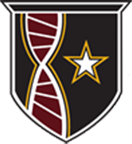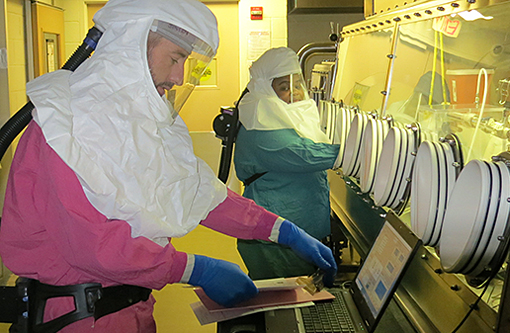Biological Safety at USAMRIID
Established in 1969, USAMRIID has decades of experience operating containment laboratories, and has provided extensive training and consultation to other agencies setting up their own facilities. We consider safety–of our employees, our neighbors, and the surrounding community–our number one priority.
There are four levels of biological containment, ranging from Biosafety Level (BSL)-1, the lowest, to BSL-4, the highest. BSL-1 would be comparable to an open bench laboratory found in a school classroom–no special precautions would be needed. At BSL-2, USAMRIID employees wear gloves, eye protection, and laboratory coats. For BSL-3 work, we require our personnel to change into scrubs before entering the laboratory, wear respiratory protection, eye protection and gloves, and take a shower before exiting. Other personal protective equipment such as non-permeable outer garments are required, depending on the tasks to be performed. BSL-4 is the highest level of containment, where employees wear positive-pressure encapsulating suits and breathe filtered air as they work.
Complete descriptions of the biosafety levels can be found in the Biosafety in Microbiological and Biomedical Laboratories (BMBL) handbook (6th Edition) at the following link:
https://www.cdc.gov/labs/BMBL.html
In addition, a combination of rigorous training, meticulous procedures, security measures, carefully designed structures, and elaborate and redundant operating systems are in place to protect our laboratory workers. These measures also ensure the safety of those outside the laboratories. Investigators working in USAMRIID laboratories are highly trained to follow established safety procedures.
Heat, pressure, and chemical systems housed in the laboratories process and decontaminate all liquid and solid wastes completely, and air passes through high-efficiency particulate air filters, making all the liquid and air effluents safe before they leave the facility. Multiple redundancies in equipment and systems help to ensure that if an unexpected failure were to occur, a backup would be in place to maintain safety.
Investigators in the laboratories study tiny amounts of infectious agents and the diseases they cause in order to develop vaccines, treatments and diagnostic tools. USAMRIID's research involving infectious agents is reviewed and approved by the Institutional Biosafety Committee, the Animal Care and Use Committee, the Portfolio Management Committee, and other internal and external reviewers as applicable. No studies can take place without careful examination of all protocols to assess risks.
The laboratories at USAMRIID are inspected and overseen by the Department of the Army, the Centers for Disease Control and Prevention, the U.S. Department of Agriculture, and many other agencies to ensure their safe and secure operation.
Laboratory Oversight
The following federal agencies and third party inspectors have oversight of USAMRIID laboratories and operations.
- A2LA – American Association for Laboratory Accreditation
- AAALAC – Association for Assessment and Accreditation of Laboratory Animal Care International
- ATF – Bureau of Alcohol, Tobacco, Firearms and Explosives
- CAP – College of American Pathologists
- CDC DSAT & USDA DASAT – Centers for Disease Control and Prevention, Division of Select Agents and Toxins & U.S. Department of Agriculture, Division of Agricultural Select Agents and Toxins
- DAIG – Department of the Army Inspector General
- DEA – Drug Enforcement Agency
- DOJ – Department of Justice
- DOT – Department of Transportation
- EPA – Environmental Protection Agency
- FDA – Food and Drug Administration
- NIH/OBA – National Institutes of Health, Office of Biotechnology Activities
- NRC – Nuclear Regulatory Commission
- OIG – Office of Inspector General
- OSHA – Occupational Safety and Health Administration
- USAMEDCOM – U.S. Army Medical Command














